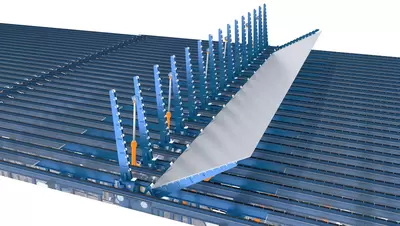
The new plate turnover device in X-Roll® MultiFlex design combines proven and new functions to the maximum benefit of customers. In addition to low-noise operation, the focus is on surface-friendly handling of the plates and on the expansion of the operating area. Investing in the new X-Roll® MultiFlex-Turnover Device ensures safe handling of both, extremely thin as well as very thick plates and of a large product mix, with the option of being adapted to future requirements.
Plant owners often had to experience that existing conventional turnover devices reached their limits. But frequently, these limits are not fully apparent until it comes to modernizations, and in particular, if the scope of modernization is to include an expansion of the product mix.
Conventional plate turnover devices are little flexible
Conventional plate turnover devices are designed to cover one plate thickness range with the turnover arms being arranged at a fixed distance to one another. This distance defines the maximum product thickness that can be turned. Hence, the manageable range of plate thicknesses is determined by the fixed distance between the turnover arms. Moreover, this distance is the crucial factor determining the maximum noise emissions generated during the turning process.
Thin plates tend to wobble in an uncontrolled manner from the lifting side to the receiving side in the gap between the turnover arms. The results can be marks and even defects on the plate surface due to the hard hits. This leads to inferior quality and causes time- and cost-consuming rework. In the case of critical materials, turning must be waived in some cases to avoid rejects, and a complex manual procedure has to be applied to check the bottom side. In addition the noise level is representing a considerable health risk to the operating staff in the plant.

In a nutshell, this means:
- The definition of a fixed, maximum thickness for conventional plate turnover devices has negative impacts on product quality and on noise emissions.
- In order to eliminate these drawbacks, SMS group has developed the patented X-Roll® MultiFlex-Turnover Device as part of an innovative plant concept.
Mature design
“With the MultiFlex-Turnover Device the balancing act between optimal design to minimize noise emissions and best possible prevention of product surface defects in the requested thickness ranges is a thing of the past. The infinitely adjustable arms of the plate turnover device allow for quick and flexible adjustment to the thickness of the plate to be turned,” says Gisbert Paß, SMS expert for finishing lines.
The mature design of the X-Roll® MultiFlex-Turnover Device substantially minimizes noise emissions during the turnover process as compared to conventional plants.
Before turning, an eccentric shaft ensures that the distance between the arms is precisely set to the gap required for the process. So, the product determines the ideal gap to be set between the arms and this prevents noisy wobbling movements. In addition, the replacement of the mechanically driven turning arm shafts by hydraulic cylinders provides additional damping and thus contributes to further improvement.
Manfred Dingenotto, Sales Manager Heavy Plate Mills at SMS group, explains the importance of plate turnover devices for new projects or for the modernization of other existing plants as follows: “Customers have to consider the total sound emission of the facility when building a new plant or modernizing an existing one. Frequently, the question arises as to whether the total noise emission might be too high. In that case, there is not only a risk for the employees inside the building, but also in the plant environment the noise level may present a problem.”
Conventional plate turnover devices are one of the main causes of noise emissions, especially noise peaks. If the problem cannot be remedied by simple means, it will be necessary to take costly measures to protect operating staff and neighborhood.


